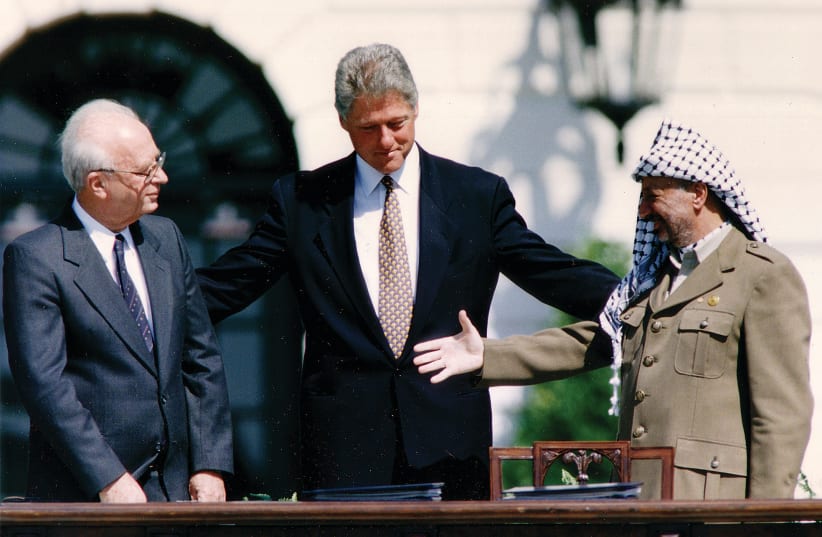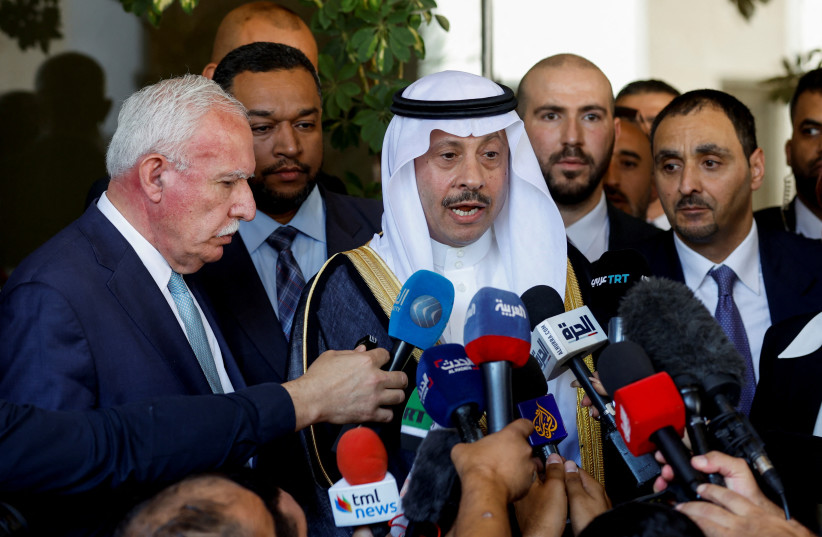(JTA) — Israel, Saudi Arabia and the United States seem intent on striking a trilateral deal that includes normalization between Israel and Saudi Arabia, Saudi civil nuclear power monitored by the international community, and an American-Saudi defense treaty. So why is it taking so long? Well, a fourth party — the Palestinians — are not part of the negotiations, yet their well-being seems to loom over the negotiations.
I’ve been in the room when Israel negotiated high-stakes questions about its relationships and its future, as the secretary for the Israeli delegation of the Camp David negotiations from 1999 to 2001. So I understand the diplomatic legacies shaping the positions at play today — and the broad implications and deep freight of the issues reportedly on the table.
September can be celebrated as the “Middle East Peace Month,” marking 45 years since the 1978 Camp David Accords (on Sept. 17); 30 years since the first Oslo Accord (on Sept. 13); and three years since the Abraham Accords (on Sept. 15, 2020). These events — and others — create a legacy that is now shaping the coming major milestone: an Israeli-Saudi normalization agreement.
The Israeli-Arab peace and normalization process formally began in 1978 with the Israel-Egypt Camp David Accords that included a Framework for Peace in the Middle East. The next major contractual milestone was the Declaration of Principles (also known as “Oslo A”) which was signed between Israel and the PLO in 1993. The declaration provided for the establishment of the Palestinian Authority as an interim self-government, as well as for further negotiations on the “outstanding issues” toward “final status.” Thereafter, dozens of agreements were signed among Israel, Jordan and the PLO, mostly until 1999, as well as with Bahrain, the United Arab Emirates and Morocco since 2020.
In spite of episodes of conflict and bloodshed and long intermissions, these milestones add up to a 45-year continuum of Israeli-Arab peacemaking, which has been bound by an overarching logic and diplomatic principles that have been reiterated for decades. One example is UN Security Council Resolution 242 that establishes that Israel will withdraw from the whole (French version) or parts (English version) of the West Bank. It appears in all major agreements signed since 1978.
For Israel and the United States — and particularly for Prime Minister Netanyahu and President Joe Biden — there is another unlikely benchmark. It is the so-called Trump Plan, which was negotiated between Israel and the US and presented in January 2020 without Palestinians contribution or participation. The Trump Plan clearly favors long-standing Israeli positions such as that all Jewish settlements will remain under Israeli sovereignty, which is why Netanyahu called it “the deal of the century.”
Nonetheless, the plan is premised on the principle of two states for two peoples, namely envisioning a Palestinian state alongside Israel, and acknowledging that the West Bank is “disputed territory” whose future must be agreed upon between Israel and the PLO. Furthermore, while the Palestinian state is envisioned to be of “limited sovereignty,” its area will be equivalent to 86% of the West Bank and all of Gaza and its capital, al-Quds, will be in the “area of Jerusalem” immediately adjacent to the current municipal borders.
Netanyahu no longer willing to concede on Palestinian issue
The unspoken challenge of the current negotiations over the Saudi deal is that Netanyahu is no longer willing to give Biden as much as he gave Trump. Meanwhile, Biden is bound by the legacies of Clinton, Bush, Obama and Trump — all of whom were explicit about having a Palestinian state in permanent status in the vast majority of Gaza and the West Bank. These legacies put pressure on Biden to do more for the two-state solution than his predecessors, Trump included.
The Saudis, eager to secure their status in the Arab world, must be “triangulating” three other reference points: The first is the 1978 Israel-Egypt Framework for Peace in the Middle East, where President Anwar Sadat established UN Security Council Resolution 242 as the founding principle for future territorial arrangements and provided the framework for the Oslo Process that led to the creation of the Palestinian Authority. The second is the Saudi peace plan, which shaped the peace initiative of the Arab League in Beirut in 2002 and then in Riyadh in 2007, which upheld the June 1967 Lines as reference point for future territorial arrangements. And the third is the success of the UAE in thwarting Netanyahu’s plans to annex parts of the West Bank in 2020 in exchange for the Abraham Accords.
In other words, how can Saudi Arabia walk back from its own plan or do less for the Palestinians than Egypt and the UAE?
These legacies create a four-point agenda for the currently unfolding negotiations:
First, regarding the PA: The United States and Saudi Arabia are likely to want to reaffirm the existing Oslo Accords, to which Israel is a signatory. These agreements establish the PA as the interim self-government in the West Bank and Gaza ahead of permanent status. In this context, negotiators are probably discussing how to prevent the expansion of settlements across the West Bank, particularly in areas that will circumvent the contiguity of a future Palestinian state, as well as how to bolster the PA’s economic wellbeing and capacities of governance and security capabilities.
Second, regarding future negotiations: The United States and Saudi Arabia are probably striving to reinstate the principle of “two states for two peoples,” which means that the future of the West Bank will be negotiated between Israel and the PLO and that the PA will eventually become a state albeit with limited powers. As mentioned, all US presidents since Clinton and all Israeli prime ministers since Barak, including Netanyahu in his past tenures. reaffirmed that principle.
The likely third point is territory. Americans and Saudis must be pressing for reiterating 242 as the baseline for future territorial arrangements. How can they demand anything less? Furthermore, it has been leaked that the parties are discussing some concrete territorial steps in the West Bank such as recategorizing lands under full Israeli control (“Area C”) as lands under Palestinian civil control (“Area B”), or placing Area B under full control of the PA (“Area A”). Any such change implies an Israeli recognition that the current sovereign arrangements the West Bank will be negotiated with the PLO.
Finally, there is Jerusalem, and particularly the Temple Mount and the location of Saudi’s embassy to Israel. The Temple Mount — where the Dome of the Rock and the Al Aqsa Mosque stand on a platform that covers the historic site of Judaism’s holy temples — is the most contentious issue between Israel and the Palestinians. All past agreements established that its fate will be determined in negotiations. Even the Trump Plan, with Netanyahu’s endorsement, suggests that the Temple Mount will be subject to a special arrangement where the Waqf of Jordan (a Muslim religious society) will play a significant role.
When Sadat visited Israel in 1977, he insisted on praying at Al Aqsa, as did the ambassador of the UAE. This week, President Recep Tayyip Erdogan of Turkey expressed a similar expectation ahead of his visit to Israel. While Israel maintains that “a unified and undivided Jerusalem is the eternal capital of Israel,” the Israeli-Arab peace process has been founded on the principle that Jerusalem’s final status will be determined in negotiations. As Saudi Arabia sees itself as a guardian of Muslim holy sites, Al Aqsa must be on its mind.
Ahead of their normalization agreement, Israel and Saudi Arabia are likely also discussing the location of their future embassies. On this point, the Saudi side can have its embassy to Israel in Tel Aviv, like all other embassies of Arab and Muslim countries, and its diplomatic mission to the PA in Ramallah, thereby signaling that the final status of Jerusalem is yet to be determined. But they may be considering a much bolder, more-for-more deal of establishing the Saudi embassy to Israel in Israeli west Jerusalem, thereby recognizing it as Israel’s capital, in exchange for having the Saudi embassy to the PA in Arab east Jerusalem. After all, seven European countries including the United Kingdom and France, in addition to the Vatican and Turkey, have their diplomatic missions to the PA within the municipal borders of Jerusalem.
Clearly, any such Saudi deal would shake the current Israeli coalition, whose founding agreements call for applying Israel’s sovereignty over the West Bank “when circumstances are right.” Such aspiration means canceling the Oslo Accords and dismantling the PA. In other words, the Saudi-Israel-US deal is as much about their relations as it is about the future of the two-state solution and the Israeli-Palestinian peace process.
The views and opinions expressed in this article are those of the author and do not necessarily reflect the views of JTA or its parent company, 70 Faces Media.

